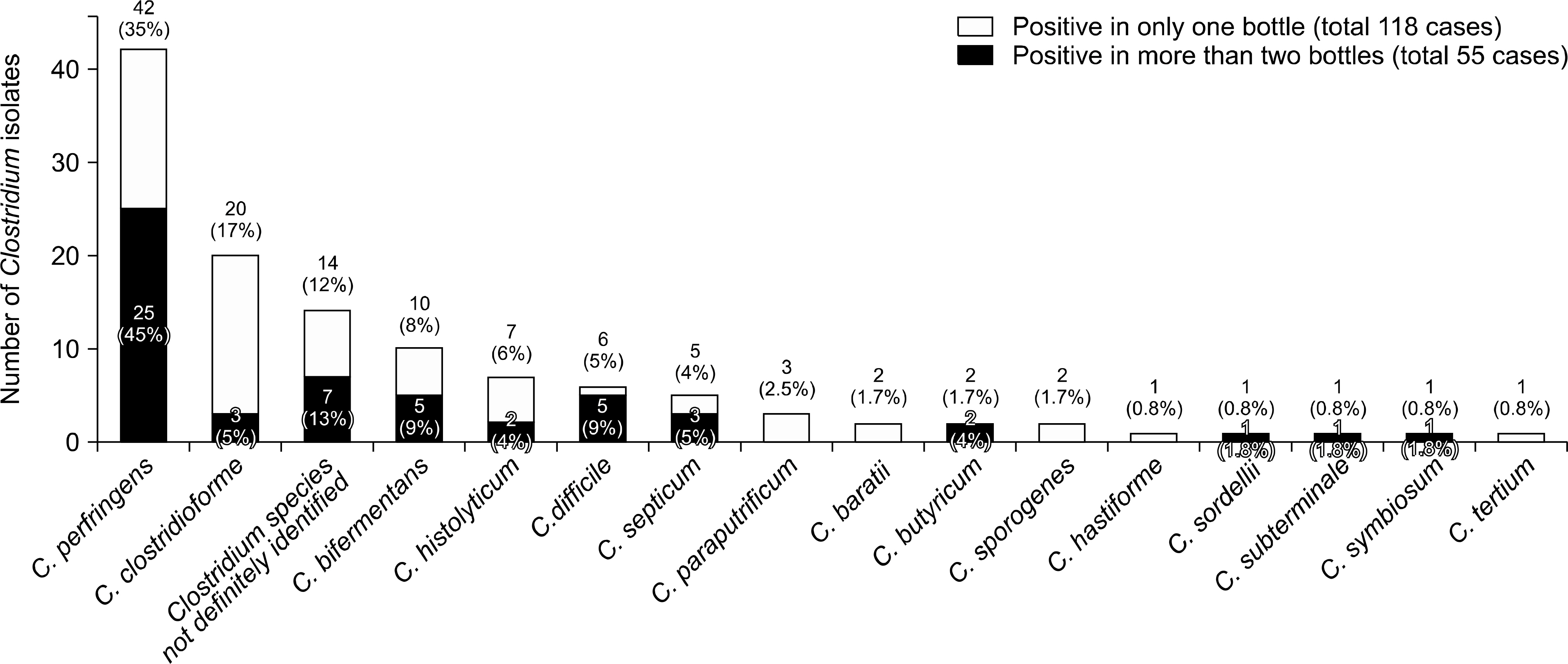Ann Clin Microbiol.
2015 Dec;18(4):126-132. 10.5145/ACM.2015.18.4.126.
Eleven-Year Experience of Clostridial Bacteremia at a Tertiary Care Hospital in South Korea
- Affiliations
-
- 1Department of Laboratory Medicine & Genetics, Samsung Medical Center, Sungkyunkwan University School of Medicine, Seoul, Korea. micro.lee@samsung.com
- 2Samsung Genome Institute, Samsung Medical Center, Seoul, Department of Molecular Cell Biology, Sungkyunkwan Universitiy School of Medicine, Suwon, Korea.
- KMID: 2133609
- DOI: http://doi.org/10.5145/ACM.2015.18.4.126
Abstract
- BACKGROUND
Clostridial bacteremia (CB) is the second most frequent anaerobic bacteremia, and CB patients show high mortality without prompt antimicrobial therapy. We retrospectively reviewed 11 years of CB cases in a tertiary care hospital to describe the clinical and microbiological characteristics of CB and to define the risk factors of fatal CB.
METHODS
All patients with CB from January 2002 to December 2012 were included in the study. Age, sex, underlying diseases, antibiotic use, and clinical outcome were reviewed. Antibiotic therapy was classified as either 'appropriate' or 'inappropriate' based on the activity against Clostridium species.
RESULTS
A total of 118 Clostridium isolates (0.79% of all blood culture isolates) were recovered from the blood cultures of 114 patients. The underlying conditions of patients with CB were neoplasm in 87 cases (76.3%), gastrointestinal symptoms in 84 cases (73.7%), diabetes in 17 cases (14.9%), and hemodialysis in six cases (5.3%). Of the 118 Clostridium isolates, C. perfringens was the most frequent species (42 isolates, 35.6%). Thirty-two patients (28.1%) showed polymicrobial bacteremia, which was most commonly combined with Escherichia coli. Two patients harbored more than two Clostridium species. 'Appropriate' antibiotics were given to 97 (85.1%) patients. The mortality rate of CB at days 2, 8, and 30 was 7.9% (9/114), 14.0% (16/114), and 26.3% (30/114), respectively.
CONCLUSION
Neoplasm, especially in the gastrointestinal tract or of hematologic origin, and hemodialysis were considered to be risk factors of blood stream clostridial infection. Early appropriate antibiotic coverage of CB was not definitely associated with lower mortality in our study.
Keyword
MeSH Terms
Figure
Reference
-
1.Goldstein EJ. Anaerobic bacteremia. Clin Infect Dis. 1996. 23(Suppl 1):S97–101.
Article2.Lassmann B., Gustafson DR., Wood CM., Rosenblatt JE. Reemer-gence of anaerobic bacteremia. Clin Infect Dis. 2007. 44:895–900.
Article3.Brook I. Anaerobic bacterial bacteremia: 12-year experience in two military hospitals. J Infect Dis. 1989. 160:1071–5.
Article4.Ingram CW., Cooper JN. Clostridial bloodstream infections. South Med J. 1989. 82:29–31.
Article5.Chen YM., Lee HC., Chang CM., Chuang YC., Ko WC. Clostridium bacteremia: emphasis on the poor prognosis in cirrhotic patients. J Microbiol Immunol Infect. 2001. 34:113–8.6.de Virgilio C., Klein S., Chang L., Klassen M., Bongard F. Clostridial bacteremia: implications for the surgeon. Am Surg. 1991. 57:388–93.7.Bodey GP., Rodriguez S., Fainstein V., Elting LS. Clostridial bacteremia in cancer patients. A 12-year experience. Cancer. 1991. 67:1928–42.
Article8.Gorbach SL., Thadepalli H. Isolation of Clostridium in human infections: evaluation of 114 cases. J Infect Dis. 1975. 131(Suppl):S81-5.9.Benjamin B., Kan M., Schwartz D., Siegman-Igra Y. The possible significance of Clostridium spp. in blood cultures. Clin Microbiol Infect. 2006. 12:1006–12.10.Rechner PM., Agger WA., Mruz K., Cogbill TH. Clinical features of clostridial bacteremia: a review from a rural area. Clin Infect Dis. 2001. 33:349–53.
Article11.Johnson S., Driks MR., Tweten RK., Ballard J., Stevens DL., Ander-son DJ, et al. Clinical courses of seven survivors of Clostridium septicum infection and their immunologic responses to alpha toxin. Clin Infect Dis. 1994. 19:761–4.12.Shah M., Bishburg E., Baran DA., Chan T. Epidemiology and outcomes of clostridial bacteremia at a tertiary-care institution. Scien-tificWorldJournal. 2009. 9:144–8.
Article13.Stevens DL., Bryant AE., Carroll KC. Clostridium. Jorgensen JH, Pfaller MA, Carroll KC, Funke G, Landry ML, Richter SS, editors. Manual of Clinical Microbiology. 11th ed. Washington, D.C.: ASM Press;2015. p. 940–66.14.CLSI. Performance standards for antimicrobial susceptibility testing; twenty-fourth informational supplement. CLSI document M100-S24. Wayne, PA: Clinical and Laboratory Standards Institute. 2014.15.Haddy RI., Nadkarni DD., Mann BL., Little DR., Domers TD., Clover RD, et al. Clostridial bacteremia in the community hospital.16.Leal J., Gregson DB., Ross T., Church DL., Laupland KB. Epidemiology of Clostridium species bacteremia in Calgary, Canada, 2000-2006. J Infect. 2008. 57:198–203.17.Zahar JR., Farhat H., Chachaty E., Meshaka P., Antoun S., Nitenberg G. Incidence and clinical significance of anaerobic bacteraemia in cancer patients: a 6-year retrospective study. Clin Microbiol Infect. 2005. 11:724–9.
Article18.Schreckenberger PC., Celig DM., Janda WM. Clinical evaluation of the Vitek ANI card for identification of anaerobic bacteria. J Clin Microbiol. 1988. 26:225–30.
Article19.Lee EH., Degener JE., Welling GW., Veloo AC. Evaluation of the Vitek 2 ANC card for identification of clinical isolates of anaerobic bacteria. J Clin Microbiol. 2011. 49:1745–9.
Article
- Full Text Links
- Actions
-
Cited
- CITED
-
- Close
- Share
- Similar articles
-
- A Case of Clostridium bifermentans Bacteremia in a Patient with Myelodysplastic Syndrome
- Clinical and microbiological features of Providencia bacteremia: experience at a tertiary care hospital
- Clinical significance of Providencia bacteremia or bacteriuria
- Patients' Experience of Participation in Hospital Care
- The Impact of Patient-centered Care on the Patient Experience according to Patients in a Tertiary Hospital


